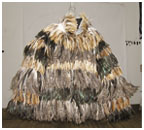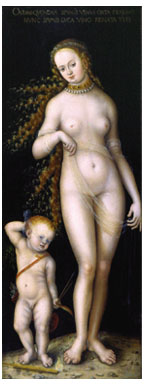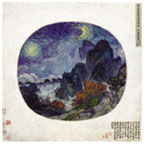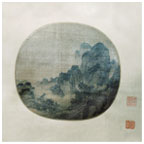March 26, 2003: Features

|
Sanford Biggers created an oversized feathered jacket, inspired by a feathered African tunic (below) in the museum’s collection.
Ellen Harvey will copy this work by Lucas Cranach, called Venus and Amor.
Anonymous (Song) — Van Gogh. The work is based on the painting (below) Landscape in the Style of Fan Kuan, by an anonymous artist.
PUAM by Zhang Hongtu, who has painted scenes from Chinese landscape drawings in the styles of Impressionists and Post-Impressionists, such as Vincent Van Gogh.
|
Art exhibition offers new perspectives on familiar works
By David Marcus ’92
Photos: Above, left, Far left, Top right,
As an art student in Beijing in the 1960s, Zhang Hongtu was taught to paint “from the eye, not the brain.” He and his peers were told to depict exactly what they saw, not to express their feelings about what they were painting. Zhang recalls that while he was a student, the National Gallery in Beijing put on a show of works created by Chinese artists before 1949, the year Mao Zedong and the Communists took control of China. Called the “negative education exhibition,” the show had one instructional purpose: to show the kinds of works students were not to make.
Ellen Harvey’s experience of museums as a Harvard undergraduate in the 1980s was entirely different: “I wanted to own all the things in the museum, or make something better.” Like many students, she copied paintings in order to learn from them. For one class, she was told to copy a work by the French Impressionist Pierre-Auguste Renoir, never a favorite of hers. “It was supposed to be a morally improving experience,” she says.
Both Zhang and Harvey, as well as artists Sanford Biggers and Anne Chu, consider museums and the traditions they enshrine in “Shuffling the Deck: The Collection Reconsidered,” which will run from March 29 through June 29 in the Princeton University Art Museum. The only criterion for the works in the show is that they be inspired by pieces in Princeton’s permanent collection. The new works by the four artists – all of whom are based in New York – will be installed within the permanent galleries. In that way, the project allows the museum both to supplement its holdings in
contemporary art, and to offer new perspectives on existing works, according to Susan M. Taylor, the museum director.
The exhibition aims to show visitors “what it’s like to see the museum through an artist’s eyes,” says guest curator Eugenie Tsai, formerly senior curator at the Whitney Museum of American Art. “I tried to think of artists whose work was open to work from different cultures and artists to whom the history of art was very pertinent. When you see a museum through an artist’s eyes, you see that there are other ways of arranging a museum and making connections” between things that have been compartmentalized.
Chu contributes four original cast-bronze and fabric sculptures based on pre-Columbian and Han Dynasty ceramic figures in the collection. Biggers’s works connect pieces in Princeton’s collection with aspects of contemporary culture. One of his pieces is an oversized winter jacket with feathers on the outside, inspired by a feathered African tunic he noticed on a trip through the museum. “Upon seeing that piece, I was struck by its physicality and material,” he says. “In Harlem, I see all these guys with these big goose-feather jackets. These guys, 500 or 600 years ago, could have been wearing that tunic.”
The show’s locale at a teaching museum was fundamental to Harvey’s piece. “I wanted to use the museum as a student,” Harvey says. “As an artist, you learn by going and copying.” After looking through the collection, she chose to copy a painting of Venus by Lucas Cranach, a 16th-century German artist and ally of Martin Luther. “The project is all about desire and the desirable object, and Venus is the quintessential desirable object,” she says.
Harvey’s exercise isn’t as simple as bringing in an easel, canvas, and paint and getting to work. Like all artists who want to copy a work in Princeton’s collection, Harvey had to sign a contract in which she agreed not to sell her piece, which must be at least 10 percent bigger or smaller than the original. When Harvey finishes the copy, it will hang in the museum where Cranach’s Venus and Amor does now. Museum-goers who notice the copy of the Cranach painting instead of the original may pause and ponder the museum as an institution. “The whole idea of a museum is a bizarre one,” Harvey says. “The things in museums all had functions, and those functions have atrophied.” Consider Cranach’s painting, which was made for a private patron: “The last thing he intended was that it hang out for the delight of Princeton undergraduates,” Harvey says.
Zhang’s four paintings for the show are part of a project he’s been working on for the last four years, in which he paints scenes depicted in Chinese landscape drawings in the styles of Paul Cézanne, Claude Monet, and Vincent Van Gogh. “I feel like I’m an actor. Today I’m Van Gogh; tomorrow I’m Monet,” says Zhang, who immigrated to the U.S. in 1982. The works aim to “blur the boundaries between Chinese and Western culture,” he says.
Knowing that Monet’s Lilies and Japanese Bridge is one of Princeton’s most famous works, Zhang went to the museum with a request: “I was looking for a bridge. If I want to combine Monet and a Chinese painting, I have to find something in common. The difference is already there.” After combing through the museum’s collection of Chinese paintings, he found a Ming dynasty fan painting by Shen Chou that has a simple bridge in the middle.
Zhang contravened Monet’s practice of painting from life by bringing
his canvas to Princeton to study the Japanese bridge, whose greenish hues
he especially wanted to match. But, notes Zhang, the Chinese artists he
imitates never painted from life; they worried about a work’s relationship
to its predecessors. And, he adds, “Cézanne said that when
you want to learn, you go to a museum.” ![]()
David Marcus ’92 is a frequent PAW contributor.





